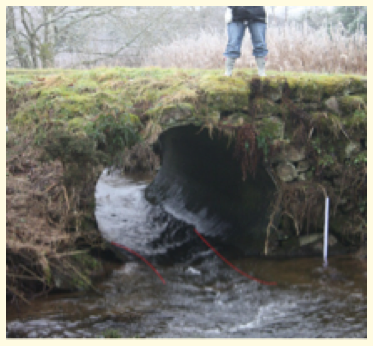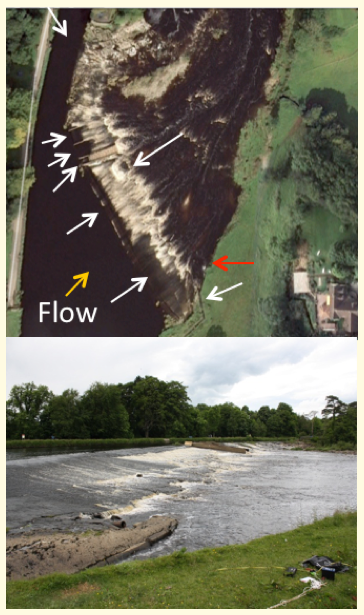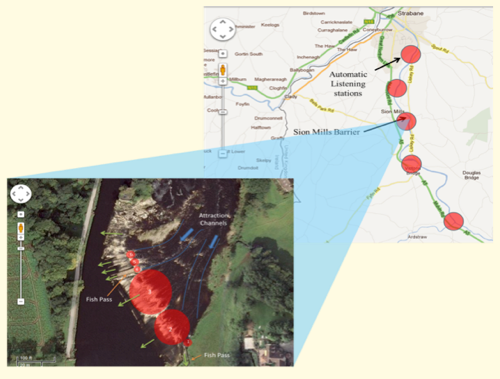 |
|

|
 |
 |

Atlantic salmon's river migration and in-stream barriers
|
 |
 |
 |
 |
 | Following on from the article about his work in the last newsletter, Matt Newton writes:
|
 |
 |
 |
 |
 |
 | Habitat connectivity is integral to survival for Atlantic salmon (Salmo salar). Salmon are anadromous in that they spawn in freshwater where juveniles grow for a number of years before migrating to sea. In the marine environment salmon feed and mature before returning to freshwater to spawn and complete their life cycle. This migration takes place over thousands of kilometres and can be impacted on at any point along its path. Migratory fish encounter various obstacles during their life cycle, one of which, and possibly the most important, is the fragmentation of the river corridor by various in-river structures. These barriers are both natural and artificial, such as; fords, dams, weirs, culverts, rapids and waterfalls, all of which have the potential to prevent migration.
|
 |
 |
 |
 |
 |
 | Complete barriers limit habitat availability, reducing distribution of populations leaving them vulnerable to isolation and extinction. Temporary or partial barriers may prevent the movement of a proportion of the population due to individual variability of swimming capabilities. For example at low flows, water depth within a culvert (figure 1) maybe so shallow that fish are simply unable to swim through it, whereas at higher flows, water velocity maybe too great for fish to swim through, once again creating a barrier, passage may only take place when water depth is deep enough or when water velocities are slow enough and vice versa. Essentially passage can only take place in specific flow ‘windows’, these windows will vary for individuals. Swimming capability is not fixed and is impacted on by fish individual swimming ability along with environmental variables (temperature, dissolved oxygen) all interacting with each other to define flow windows where passage can take place.
Figure 1: Culvert, water velocity and depth can cause impediments to migration under certain conditions (red line indicate main flow)
|
 |
 |
 |
 |
 |
 | The European Union Water Framework Directive (WFD) requires that Member states achieve ‘Good ecological status of water bodies which have been heavily modified, by 2015.’ One of the key requirements for the directive is the need for unimpeded fish migration, emphasizing the need to mitigate the ability of fish to migrate up and downstream unconstrained. To meet minimum requirements for the WFD the river or water course must be in a state where there is connectivity between all river zones from estuary to source in both upstream and downstream directions.
A common research theme throughout the literature is the behaviour of Atlantic salmon in response to hydro-power installations and the fish passes associated with such impoundments, yet small scale barriers, which are generally temporary, are vastly understudied. In order to study migration and effects of barriers successfully, we rely on complex telemetry studies which enable the visualisation of fish movement and their response to specific variables. To date, telemetry studies tend to be observational, describing migration and movement patterns, thereby identifying bottlenecks within river systems, however the underlying drivers for migration failure are overlooked. Such telemetry studies are expensive and generally limited to large scale dams with electricity companies provide funding to improve fish passage at their own facilities. However the Environment Agency has estimated that there are over 26,000 in-river barriers suitable for hydropower use, and many more which are also considered migration barriers. This is a vast amount compared to the handful of large scale dams present within our waterways, where research is focussed and mitigation is developed. The impacts of small scale barriers to migration, of Atlantic salmon, remains relatively unknown.
Physiology and energetics are fundamental to migrations, an understanding of these through non-lethal biopsies and conditional assessments combined with telemetry allow for an understanding in the success and failure of populations. These techniques do not allow for real time analysis of data, however they do provide an insight into the condition of the fish at the time of release, coupling this with positional behaviour and movement will allow for hypotheses to be tested in relation to condition, behaviour and fate. Adult Atlantic salmon rely on energy reserves built up within the marine environment, highlighting the potential for fitness costs to be acquired through slow passage. If fish are spending more time attempting to ascend barriers, this ultimately leaves less energy available for mating and reproduction. The hypothesis that delay at river barriers influences individual fitness remains unanswered. By determining how migration behaviour below barriers relates to the overall fate of an individual is imperative to understanding how widespread and cumulative these effects (of multiple barriers on a single river) may have on the ecology of migratory fish. In order to provide successful management tools to aid in the migration of Atlantic salmon there is a clear requirement for mechanistic understanding of how initial traits; condition, behaviour and environmental conditions interact and ultimately determine migration success and reproductive ability. The potential of telemetry studies is endless; following biopsied fish is simple, with the insight into links between fates and physiology being invaluable.
|
 |
 |
 |
 |
 |
 | My project will and has undertaken a novel telemetry study in an attempt to identify fish behaviour in relation to small scale barriers and examine reasons for passage success or failure.
The main study sight is a small scale sloping weir at Sion mills, County Londonderry, Northern Ireland (Figure 2). The weir provides various passage routes for fish (up to 9) including two fish pass channels.
Each passage channel will change in relation to flow variation, so as one channel may become impassable, another channel may subsequently become passable.
Figure 2: Aerial view (above) with potential passage channels indicated with white arrows, and side view (below) looking across the weir as indicated by red arrow in aerial view
|
 |
 |
 |
 |
 |
 | With the summer of 2012 being the wettest on record (http://www.bbc.co.uk/news/uk-19427139) the project was somewhat delayed due to 1km of cabling required to be laid across the weir itself. Nonetheless a detection array was established below the weir at sion mills (Figure 3) that enables the fine scale movements of tagged individuals to be analysed.
The first fish was tagged on 30/08/2012 with a further 11 fish (12 total) tagged in the following weeks. These fish were then tracked throughout the Foyle catchment on a daily basis. A great variety of behaviour has been seen, from individuals passing the weir within hours of release post tagging, to delays of over 30 days with other individuals. Passage has been undertaken at a variety of flows and temperatures, parameters which are often considered key to fish passage, with direct influences on successful passage being hard to tease apart. The primary problem with data analysis is the (current) small sample size. To combat this, over 60 individuals will be tagged throughout June and July 2013, and it is expected that increased sample size will enable the impact of the riverine barrier to be identified, this sample size is one of, if not the largest sample size of such a study within the UK.
|
 |
 |
 |
 |
 |
 | This is the very first fish tagged within the project on 30/08/2012. Following tagging this fish moved steadily downstream approximately 1km where it held stationary in one pool. 32 days later this fish approached the weir, but failed to pass, and moved between detection zones at the weir and a detection zone 200m downstream, three times as if to be ‘testing’ the weir for passage. Failing to ascend the weir the fish moved back downstream, past the pool where it was initially holding, and remaining in this second downstream (approx 2km) location. Following a brief period of inactivity the fish returned to the weir where following a further two transitions between the weir and holding pool (downstream), it eventually had a successful passage attempt and headed upstream to spawn. On 18/02/2013 this fish was recorded migrating downstream into Loch Foyle as a kelt post spawning, six months after first entering the river and being tagged in the study.
|
 |
 |
 |
 |
 |
 | This fish was tagged on 17/09/2012, and was not detected within the river for a month post release, despite multiple searchers both in the tidal reaches and freshwater sections of the River Foyle this fish was not detected and therefor deemed to have returned to the sea in Lough Foyle. This fish has indicated the ability to move between both fresh and salt water in relatively short periods of time, something which is physiologically challenging in regard to being able to deal with salinity variances between the two environments. On 16th September this fish arrived back into freshwater being detected at the weir, which it subsequently passed and headed upstream to spawning grounds.
|
 |
 |
 |
 |
 |
 | The fast approaching summer will pave the way for this project to develop drastically, with an increase in sample size to enable relationship/patterns and effects to be identified, along with a number of extra small scale barriers being instrumented in an attempt to identify cumulative barrier impacts.
|
 |
 |
|


 |
 |
 |



